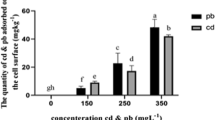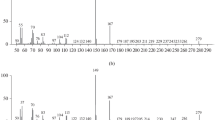Abstract
Rhizopus nigricans, isolated from an industrial effluent (paper mill), was resistant to pentachlorophenol (PCP) in Petri dishes and in submerged cultures (100 and 25 mg l−1 respectively). It was shown that this strain of R. nigricans can remove PCP in submerged culture. When 12.5 mg of PCPl−1 were added at 48 h, this compound had been completely removed by 144h. Results indicated that the fungus did not produce extracellular lignin peroxidase (LiP) and laccase, but extracellular phenoloxidase production was observed. The synthesis of the latter enzyme was stimulated by the presence of PCP and/or tyrosine. These results indicate that this fungus, and probably other filamentous fungi, have an interesting potential to be used in processes for chlorophenol biodegradation.
Similar content being viewed by others
References
Ainsworth, A.M. 1995 Technical information sheet No. 11: isolation techniques for basidiomycetes. World Journal of Microbiology and Biotechnology 11, 364–366.
Alleman, B.C., Logan, B.E. & Gilbertson, R.L. 1992 Toxicity of pentachlorophenol to six species of white rot fungi as a function of chemical dose. Applied and Environmental Microbiology 58, 4048–4050.
Badkoubi, A., Stevens, D.K. & Muraka, I.P. 1996 Quantification of pentachlorophenol transformation products distribution in the presence of Phanerochaete chrysosporium. Archives of Environmental Contamination and Toxicology 30, 1–8.
Cserjesi, A.J. & Johnson, E.L. 1971 Methylation of pentachlorophenol by Trichoderma virgatum. Canadian Journal of Microbiology 18, 45–49.
Fahr, K., Wetzstein, H.G., Gry, R. & Schlosser, D. 1999 Degradation of 2,4-dichlorophenol and pentachlorophenol by two brown rot fungi. FEMS Microbiology Letters 175, 127–132.
Guiraud, P., Seigle-Murandi, F., Steiman, R. & Benoit-Guyod, J.L. 1992 Extracellular phenoloxidase activity of micromycetes from various taxonomic groups. Microbiologica 15, 367–390.
Harking, J. & Obst, J.R. 1973 Syringaldazine, an effective reagent for detecting laccasa and peroxidase in fungi. Experientia 29, 381–387.
Kwasniewska, K. 1981 The degradation of pentachlorophenol by fungus of Fusarium sp. Trace Subs. Environmental Health 15, 392–398.
Lamar, R.T. 1992 The role of fungal lignin-degrading enzymes in xenobiotic degradation. Current Opinion in Biotechnology 3, 261–266.
Lamar, R.T., Larsen, M.J. & Kirk, K.T. 1990 Sensitivity to and degradation of pentachlorophenol by Phanerochaete chrysosporium spp. Applied Microbiology and Biotechnology 56, 3519–3526.
Leyva, R.R., Serrato, V.L.E., Guerrero, C.R.M. & Mendoza, B.J. 1996 Descomposición enzimética del fenol en solución acuosa usando tirosinasa. Avances en Ingeniería Quimíca 6, 41–45.
Lin, J.E., Wang, H.Y. & Hickey, R.F. 1989 Degradation kinetics of pentachlorophenol by Phanerochaete chrysosporium. Biotechnology and Bioengineering 35, 1125–1134.
Logan, B.E., Alleman, B.C., Amy, G.L. & Gilbertson, R.L. 1994 Adsorption and removal of pentachlorophenol by white rot fungi in batch culture. Water Research 28, 1533–1538.
Mileski, G.J., Bumpus, J.A., Jurek, M.A. & Aust, S.D. 1988 Biodegradation of pentachlorophenol by the white-rot fungi Phanerochaete chrysosporium. Applied and Environmental Microbiology 54, 2885–2889.
Okeke, B.C., Smith, J.E., Paterson, A. & Watson-Craik, LA. 1996 Influence of environmental parameters on pentachlorophenol biotransformation in soil by Lentinula edodes and Phanerochaete chrysosporium. Applied Microbiology and Biotechnology 45, 263–266.
Seigle-Murandi, F., Guiraud, P., Steiman, R. & Benoit-Guyod, J.L. 1992 Phenoloxidase production and vanillic acid metabolism by zygomycetes. Microbiologica 15, 157–165.
Seigle-Murandi, F., Steiman, R., Benoit-Guyod, J.L. & Guiraud, P. 1993 Fungal degradation of pentachlorophenol by micromycetes. Journal of Biotechnology 30, 27–35.
Thompson, D.P. & Cannon, C. 1984 Extracellular phenoloxidase activity in Rhizopus and Mucor species. Mycologia 76, 567–568.
Tien, M. & Kirk, T.K. 1988 Lignin peroxidase of Phanerochaete chrysosporium. In Methods in Enzymology, eds. Wood W.A. and Kellog S.T., vol. 16, pp. 238–249. New York: Academic Press.
Tomasini-Campocosio, A., Villareal-Arellanos, H.R. & Barrios-Gonzalez, J. 1996 Resistencia de una cepa de Rhizopus sp. al crecer en medios conteniendo pentaclorofenol. Avances en Ingeniería Quimíca 6, 36–40.
Author information
Authors and Affiliations
Rights and permissions
About this article
Cite this article
Tomasini, A., Flores, V., Cortés, D. et al. An isolate of Rhizopus nigricans capable of tolerating and removing pentachlorophenol. World Journal of Microbiology and Biotechnology 17, 201–205 (2001). https://doi.org/10.1023/A:1016694720608
Issue Date:
DOI: https://doi.org/10.1023/A:1016694720608




